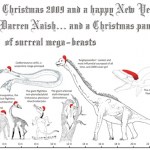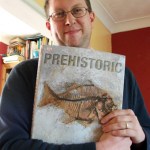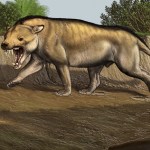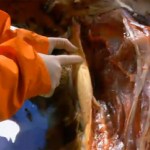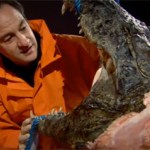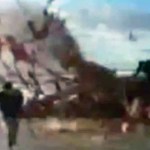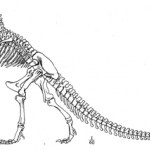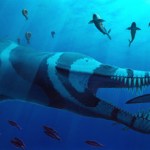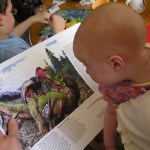community
John Michael Greer has a superb piece up about our reluctance to seriously consider real community and organizational strategies. I think it is well worth reading for anyone interested in this question of community - because we have to ask ourselves, if this is the tool we've got, why do so few of us want to do the work? Why are so few of us able to do the work?
It's interesting to speculate about why that took place. I suspect many of my readers have encountered Robert Putnam's widely discussed book Bowling Alone (2000), which traced the collapse of social networks and institutions…
In time-honoured fashion, once more it's time to wish you all best Christmas wishes and share with you my digital 'Christmas card'... though if you're a regular correspondent or one of my Facebook friends you'll already have seen it, sorry...
A larger version is available on request. You'll note a random assortment of real and not-so-real tetrapods. Qilin parungulatus comes from this article, Anachrodactylus is explained here, and the idea that Deinocheirus might have been an arboreal slothosaur is discussed here (the idea is certainly erroneous, by the way). The giant pongine is, obviously…
You're being interviewed for a TV documentary, and that documentary will focus on your special area of expertise. For the purposes of this article, let's pretend that you're an expert on sauropod dinosaurs. While being interviewed, you're asked about the possible function of a peculiar and enigmatic structure: the cavernous expansion present in the sauropod sacral region. As everyone knows, the idea that the sacral expansion might have functioned as a sort of 'second brain' was once mooted in the literature, and - because it was a fun idea that jived well with the well-known fact that…
More thoughts on the ZSL meeting 'The Secret World of Naked Snakes', held on Monday 7th December. In the previous article I discussed Mark Wilkinson and David Gower's presentations [for relevance of pic used above, read on].
Alexander Kupfer was up next, and provided an excellent overview of reproductive diversity, viviparity and parental care in caecilians (his talk was titled 'Yummy mummy: skin feeding and caecilian reproductive biology') [images above, from Wilkinson et al. (2008), show mother Siphonops annulatus looking after, and feeding, babies]. Caecilians exhibit five different…
On Monday 7th December the Zoological Society of London (ZSL) hosted the one-off event 'The Secret World of Naked Snakes' (part of the ZSL's 'communicating science' series): a whole meeting devoted entirely to those bizarre, poorly known, limbless, worm-like amphibians, the caecilians. The meeting was attended by over 100 people, which really isn't bad going, especially when some of the organisers expressed fears that the event would only be attended by (to quote David Gower) "A handful of caecilian freaks".
Ken Livingstone [shown here] - former Mayor of London and well-known amphibian…
Preparing blog posts for Tet Zoo takes hours, sometimes days or even weeks. It's done in "spare time". Putting crap on facebook takes minutes and can be done during the course of a normal work day. Some of the stuff is soooo hilarious it deserves to be shared...
Francisco Gascó (aka Paco) knocked this up, thanks Paco. It was taken in about 1992 1994 (when I was 18 19): note the Battat dinosaurs on the terrarium lid, Greg Paul theropods on the wall, and Luis Rey spiky amargasaur t-shirt. The croc skull is a juvenile C. niloticus.
My one and only photo of a British big cat, taken on Dartmoor…
Regular readers will know that my new book, The Great Dinosaur Discoveries (A & C Black in UK; UCP in US), was released over the last few weeks. By all accounts, it's currently selling well and the reviews that have appeared so far have all been outstandingly positive [example]. Things are looking good. But I work hard, and over the last couple of weeks I've received the news that a second book I completed at about the same time is also now out. Today I received my copy, so can at last talk about it.
Titled Prehistoric here in the UK (and Prehistoric Life in North America), the book is…
If you've been enjoying the series on mesonychians you'll be pleased to hear that it's not completely over. There are a few groups yet to come (though, as we'll see, whether they really are mesonychians or not is controversial. 1000 Tet Zoo dollars* to whomever guesses the names of the groups I'm talking about). Anyway: you can't think awesome extinct Cenozoic mammals and not think Carl Buell. They're kind of synonymous. And, whaddayaknow, here's something incredible...
Yes, Carl has done an Andrewsarchus. Sincere thanks to Carl for allowing me to use it; I won't say much as the picture…
Yeah, what the hell, what have I got to lose, what's the worse that could happen, and other such platitudes... I finally decided, after an annoying number of prompts and requests and so on, to join the time-sucking black hole of frivolity that is Facebook. Thus far I've used it to piss around and post pictures like those below - but isn't that what it's for?
Apparently it can serve some of useful purpose, but I'm sure I'll get to that eventually. If I slowly start to lose interest in the blogosphere, you'll know why. And if you want to know who to blame: Max Blake, j'accuse.
First of all, I've been away (speaking about fossil cats again), though - as previously - you might not have known this given that a list of posts were scheduled to appear in my absence. Is there more on mesonychians to come? There might be, but I haven't yet had the time to finish it. Meanwhile....
For months and months now my esteemed colleague and coauthor Mark Witton has been working on a secret project. It's pretty incredible and the temptation to blab about it and post some of the neat photos I have has been overwhelming (one of the photos is shown below: it was taken back in May).…
On to our second day of talks (read part I first): things kicked off with Mike A. Taylor and Angela Milner's talk on the history and collections of Street. Pinpointing the locations of original quarries is always difficult as exact records are often not kept, and of course the areas once used for quarrying change function and appearance over time. One interesting point is that the concept of 'Street' as a locality should perhaps be interpreted as broadly as possible, given that certain other, nearby Somerset sources might sometimes have provided specimens too [adjacent photo by Mo Hassan of…
I promised myself back in 2007 that I'd cut down on the number of conferences I attend. There's a problem with that: I'm pretty bad at keeping promises (at least, to myself). This year I'm attending a ridiculous four conferences, and I've just returned from the first of them (please remind me why I have no money, and no spare time). Entitled Sea Dragons of Avalon: the early radiations of the marine reptiles and recovery from the Triassic-Jurassic faunal crisis, with special reference to Street in Somerset and the wider British record, this Palaeontological Association (Pal Ass) seminar…
If you've been paying attention you'll know that I've been absent for a little while: I've been at the Sea Dragons of Avalon conference, held at Street in Somerset and focusing on the evolution of marine reptiles (and other organisms) across the Triassic-Jurassic boundary. The meeting also included a tribute to Arthur Cruickshank, a day of 'Arthur-themed' talks, and a public lecture by Ryosuke Motani. And then there were collection visits and field trips; all in all, a major event. It went well and I have a lot to talk about: more details soon (for information on the sign shown in the…
Welcome to the last article in my little series on Inside Nature's Giants (see part I, part II and part III first). The final, fourth episode looked at giraffes (or, specifically, Rothschild's giraffe Giraffa camelopardalis rothschildi, or G. rothschildi if you prefer). For me this was the most impressive episode; partly because they covered just about everything you could think of, and partly because I haven't seen inside a giraffe before. Graham Mitchell was on-hand as their giraffe expert (is this the same Graham Mitchell who also publishes on crocodile farming?). They showed us the…
The third episode of Inside Nature's Giants (still available to watch, if you're in the UK) looked at a 17-year-old, 4 m long Nile crocodile Crocodylus niloticus that had died (very much prematurely) at a crocodile park in France (please read part I and part II unless you have already). RVC pathologist Alun Williams tried to work out the cause of death. Greg Erickson was the on-site crocodile expert, so (as expected) jaw anatomy and bite force were focused on to begin with (see Erickson et al. 2003a, b). The pterygoideus muscles - you can see some of them here, with Erickson in the…
The second episode of Inside Nature's Giants (read part I first) looked at whale anatomy: this time round, the autopsy was carried out on a Fin whale Balaenoptera physalus that had died off the coast of County Cork, southern Ireland.
Whereas the other dissections all took place in the RVC, this one was carried out in place on a beach, meaning that the weather, tides and light all intervened and spread the dissection out over two days (hence the rain spots on the image above; © Channel 4). The whole event was led by Joy Reidenberg, and toward the end of the episode she was literally standing…
Over the past few weeks, Channel 4 here in the UK screened the four-part series Inside Nature's Giants. If you're at all interested in the world of zoology you'll already - I assume - have heard quite a lot about it. I watched it religiously, and let me tell that you that it was excellent, well deserving of the Tet Zoo stamp of approval. More importantly, it was - as billed - pretty much the first time that this sort of thing had been done for television. The public face of natural history is, let's face it, behaviour, behaviour, behaviour, behaviour, ecology, conservation, conservation,…
A little while ago, news of a new paper by Devon Quick and John Ruben, both of Oregon State University, appeared on the newswires. It got its fair share of publicity.
Entitled 'Cardio-pulmonary anatomy in theropod dinosaurs: implications from extant archosaurs', the paper (Quick & Ruben 2009) purports to show that modern birds are fundamentally different from non-avian dinosaurs in terms of abdominal soft-tissue morphology, ergo birds cannot be modified dinosaurs. In slightly more detail, the paper asserts that a specialised 'femoral-thigh complex', combined with a synsacrum and…
My mate Bob Nicholls (of Paleocreations) has been producing some awesome artwork lately. Why, for example, there's this...
... and this...
The first illustration (both pics © Bob Nicholls and used with permission) shows the Jurassic pliosaur Liopleurodon Pliosaurus performing its usual trick: modifying other plesiosaurs such that they become manageable chunks. In the second piece, a group of the Cretaceous ichthyosaur Platypterygius prey on fish. As I'm sure I've said before, Platypterygius encompasses a pretty substantial diversity: numerous species have been named and it's likely that '…
Here's a recent photo showing the proofs of one of my books. These particular pages (which focus on the 'dinosaur renaissance' of the 1960s and 70s) feature a Luis Rey piece: as usual, poor Tenontosaurus is getting dispatched by a Deinonychus gang. As you can see, Emma thought the picture looked neat (Will plays with Lego power miners in the background. The photo has already been featured here at Querencia)...
I sent the photo round to a few friends. Comments so far have included "I think it's more she is querying the extent of feathering, surely?", "That is beautiful * you will get it…
